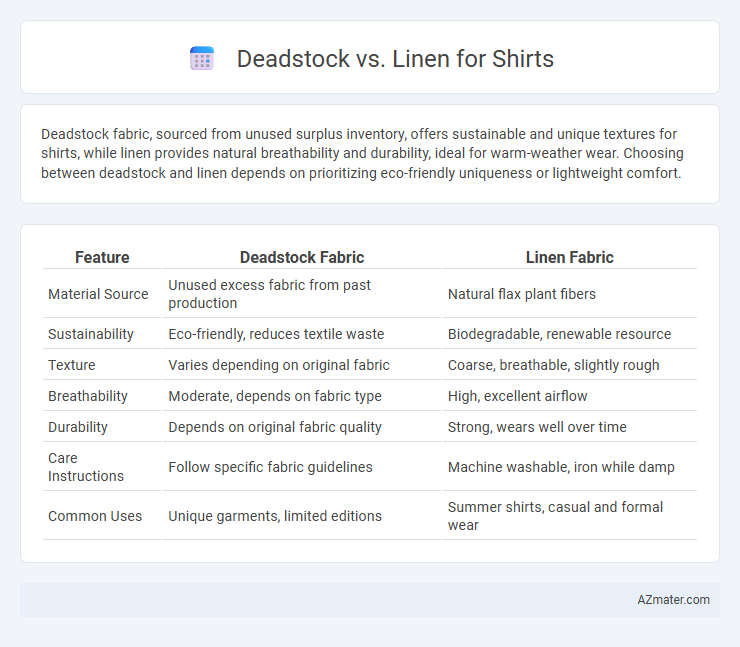Deadstock fabric, sourced from unused surplus inventory, offers sustainable and unique textures for shirts, while linen provides natural breathability and durability, ideal for warm-weather wear. Choosing between deadstock and linen depends on prioritizing eco-friendly uniqueness or lightweight comfort.
Table of Comparison
| Feature | Deadstock Fabric | Linen Fabric |
|---|---|---|
| Material Source | Unused excess fabric from past production | Natural flax plant fibers |
| Sustainability | Eco-friendly, reduces textile waste | Biodegradable, renewable resource |
| Texture | Varies depending on original fabric | Coarse, breathable, slightly rough |
| Breathability | Moderate, depends on fabric type | High, excellent airflow |
| Durability | Depends on original fabric quality | Strong, wears well over time |
| Care Instructions | Follow specific fabric guidelines | Machine washable, iron while damp |
| Common Uses | Unique garments, limited editions | Summer shirts, casual and formal wear |
Understanding Deadstock Fabric
Deadstock fabric refers to unused, leftover textile materials from previous production runs, often vintage or discontinued, valued for its uniqueness and sustainability in shirt making. Unlike linen, which is a natural fiber derived from the flax plant known for its breathability and moisture-wicking properties, deadstock fabrics can vary widely in composition and texture depending on their original use and era. Choosing deadstock for shirts emphasizes eco-conscious fashion by repurposing existing materials, while linen prioritizes comfort and natural fiber benefits in warm climates.
What Is Linen?
Linen is a natural fiber derived from the flax plant, prized for its breathability, durability, and moisture-wicking properties, making it ideal for lightweight, comfortable shirts. Unlike deadstock fabric, which consists of unused leftover materials from previous productions, linen offers a sustainable and renewable option that ages gracefully with wear. Its distinctive textured weave and ability to keep wearers cool in warm weather underscore linen's popularity in crafting premium, breathable shirts.
Sustainability Comparison: Deadstock vs Linen
Deadstock fabric repurposes unused textile inventory, significantly reducing waste and the environmental footprint associated with new fabric production. Linen, derived from flax plants, offers natural biodegradability and requires less water and pesticides than cotton, contributing to its sustainability. Comparing the two, deadstock maximizes material usage by preventing waste, while linen promotes eco-friendly cultivation and biodegradability, both supporting sustainable fashion through different approaches.
Comfort and Breathability
Deadstock fabric, often made from high-quality cotton, provides durability but may lack the lightweight breathability of linen, making it slightly less comfortable in hot climates. Linen, derived from flax fibers, excels in moisture-wicking and airflow, offering superior breathability and a cool, comfortable feel ideal for warm weather shirts. The natural texture of linen promotes ventilation, whereas deadstock cotton shirts may retain more heat, impacting overall comfort levels.
Durability and Longevity
Deadstock fabrics often offer superior durability due to their tightly woven fibers and high-quality vintage production standards, making shirts crafted from deadstock more resilient to wear and tear. Linen shirts, while breathable and comfortable, tend to have a shorter lifespan because of the natural fiber's propensity to weaken and fray over time with frequent washing. Choosing deadstock fabric for shirts ensures longer-lasting garments, as the dense weave and robust fibers withstand repeated use better than linen's delicate, moisture-absorbent strands.
Environmental Impact
Deadstock fabric significantly reduces environmental impact by repurposing surplus materials that would otherwise contribute to landfill waste, lowering the demand for new textile production and conserving resources. Linen, derived from flax plants, offers biodegradability and requires less water and pesticides than cotton, making it an eco-friendly choice with a smaller carbon footprint throughout its lifecycle. Choosing deadstock or linen fabrics for shirts supports sustainable fashion practices by minimizing waste and promoting renewable, low-impact materials.
Style and Aesthetic Differences
Deadstock fabrics offer a vintage-inspired aesthetic with unique texture and patterns that evoke nostalgia, making shirts crafted from them stand out with character and individuality. Linen shirts provide a fresh, breathable, and natural look characterized by subtle wrinkles and a lightweight feel, ideal for casual and elegant summer styles. The contrast between deadstock's rarity and linen's classic simplicity influences style choices, catering to distinct fashion preferences and occasions.
Cost Analysis
Deadstock shirts often provide a cost-effective option due to the reutilization of excess or leftover fabric, significantly reducing material expenses compared to linen, which is a premium, natural fiber known for its durability and breathability. Linen shirts typically incur higher costs because of labor-intensive weaving processes and the price volatility of flax crops, whereas deadstock relies on existing inventory that mitigates raw material procurement costs. When conducting a thorough cost analysis, choosing deadstock can lower overall expenditure while maintaining unique aesthetics, whereas linen commands a price premium justified by its comfort and longevity.
Care and Maintenance
Deadstock shirts typically require gentle washing with cold water and air drying to preserve vintage fabric integrity and prevent shrinkage. Linen shirts benefit from regular washing to maintain breathability and softness, though they may wrinkle easily and often require ironing while damp. Both fabrics avoid harsh chemicals; deadstock demands careful handling due to age, while linen needs consistent moisture to retain its natural fibers and durability.
Choosing the Right Fabric for Your Shirt
Deadstock fabric offers unique, vintage textiles with limited availability, ideal for eco-conscious shirt enthusiasts seeking distinctive styles. Linen, known for its breathability and lightweight texture, provides superior comfort and durability, perfect for warm climates and casual wear. Selecting between deadstock and linen depends on prioritizing sustainability and rarity against comfort and functionality in your shirt fabric choice.

Infographic: Deadstock vs Linen for Shirt
 azmater.com
azmater.com